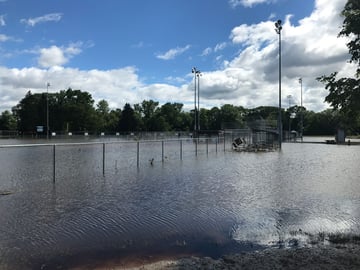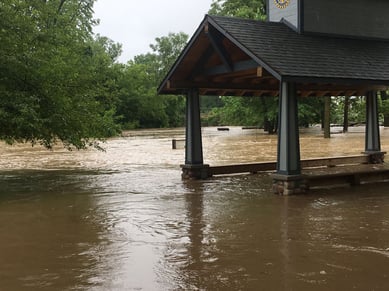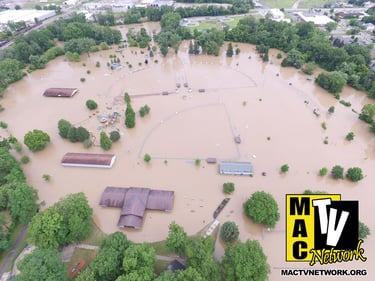|
|
|
Flooding in Mt. Pleasant, Michigan (Photos Courtesy of the City of Mt. Pleasant) |
Implement flood resilience measures to protect your Community Water Systems
This year’s horrific Atlantic hurricane season, described as the most expensive one in history, resulted in $202.6 billion in damages. As you look ahead to 2018, how would you score your flood resilience for your water systems – no matter where you live? When you are faced with the dangers of flood water and potential contamination, are you set to open your emergency plan and start implementing it as the waters rise around you?
Each weather event is different, but a comprehensive plan provides a strong framework that streamlines processes in critical flood water situations. And besides the plan, Malcolm Fox, outgoing water superintendent, Mt. Pleasant, Mich., suggests scheduling mock emergencies to practice coordination with emergency control centers. He encourages other municipal utility officials to “step up their game” with more preparation for this critical function.
Flood Resilience Process
Community Water System (CWS) operators typically have sound plans in place to handle the next flood or disaster. But are you missing something that could improve your response? Check out Flood Resilience: A Basic Guide for Water and Wastewater Utilities prepared by the U.S. Environmental Protection Agency (EPA). This guide encourages utilities to follow the four-step process to increase their resilience to flooding:
- Understand the Threat of Flooding
- Identify Vulnerable Assets & Determine Consequences
- Identify and Evaluate Mitigation Measures
- Develop Plan to Implement Mitigation Measures
The EPA describes “flood resilience” as “the ability of water and wastewater utilities to withstand a flooding event, minimize damage and rapidly recover from disruptions to service.” Consider mitigation measures to build your resilience. Examples include:
- Emergency Response Plan
- Barriers around key asset
- Elevated electrical equipment
- Emergency generators
- Bolted-down chemical tanks
Associations like the Florida Rural Water Association believe in the importance of flood resilience. It conducted workshops to educate operators of water and wastewater systems about the process of flood resilience and mitigation.
|
|
|
Flooding in Mt. Pleasant, Michigan (Photos Courtesy of the City of Mt. Pleasant) |
Lessons Learned
Now that the waters have receded, many municipal officials who dealt with flooding have turned from immediate challenges to more long-term solutions. Like many water officials, Fox is looking back at his flooding experience earlier this year and creating a to-do list that will help with future weather events. His tasks include the following:
- Store pre-positioned sandbags that are ready to go
- Purchase mobile diesel fuel tanks for generators
- Set up mutual aid agreements with communities 40-50 miles away
- Meet with local utilities to find out what backup equipment is available
In addition, Mt. Pleasant will be elevating its major switch generators and transformers to avoid potential flooding. This year’s flood waters almost destroyed some of the equipment.
The EPA’s Flood Resilience Guide suggests that utilities measure the elevations of their assets to determine vulnerability to flooding. Then the next step is to determine consequences based on replacement costs and impacts to facility operators. Finally, utilities can determine the priority need for mitigation to improve flood resilience.
The dangers of flood water are varied. Keeping backflow preventers out of vaults is one way to reduce the risk of illness after a flood
Centralized Communication
Jamie Hockemeyer, water treatment plant superintendent for Mt. Pleasant, explained how pre-planning provided an efficient communication process to deal with flooding in the community with a population of about 26,000 plus the Central Michigan University student population (15,000-20,000). The process used during the flood followed the Incident Command System (ICS), a structure set up by the Federal Emergency Management Agency (FEMA)/Homeland Security.
The Isabella County Emergency Operations Center received all communications from governmental units, including the water department officials, Michigan State Police and FEMA. A direct line provided access to the governor. Press releases were set to go regarding the need to boil water to remove contaminants and notifications to residents who may not have service due to water main breaks.
Address communication procedures in your Emergency Response Plan. According to the EPA, the plan should identify clear communication channels for CWS staff and personnel, external non-CWS entities and the public/media. As part of the plan, officials are urged to keep internal and external notification lists that contain comprehensive contact information of appropriate entities.
|
|
|
Shepherd Cross Country & Track and Field, Mt. Pleasant, Mich. (Carey Hammel Photo, Courtesy of MAC TV Network) |
Emergency Response Plan
In addition to communication procedures, the EPA recommends that your utility’s Emergency Response Plan contains the following core elements:
- System Specific Information
- CWS Roles and Responsibilities
- Personnel Safety
- Identification of Alternate Water Sources
- Replacement Equipment and Chemical Supplies
- Property Protection
- Water Sampling and Monitoring
Besides flooding, the Emergency Response Plan can be used to address other major events, such as acts of terrorism, other natural disasters or catastrophic incidents.
Preparing for Future
Are flood concerns keeping you up at night? Planning can’t stop the flood waters, but it can arm you with some best management practices to keep your community safe and reduce asset damage.
Leslie Blaize, Certified Professional Services Marketer and owner of Blaize Communications, specializes in writing about the Architecture/Engineering/Construction industry. See www.blaizecommunications.com.






